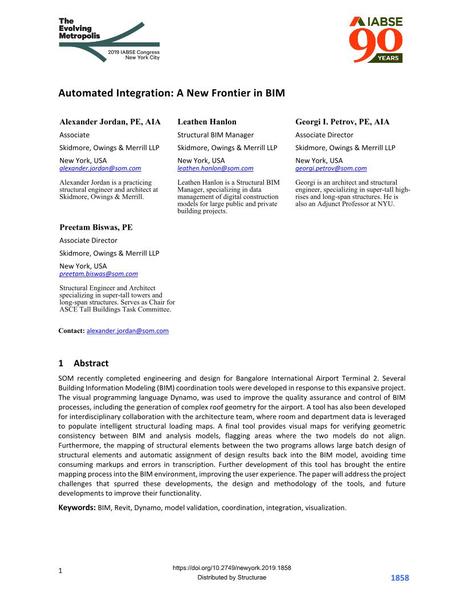Automated Integration: A New Frontier in BIM

|
|
|||||||||||
Détails bibliographiques
| Auteur(s): |
Alexander Jordan
(Skidmore, Owings & Merrill LLP)
Leathen Hanlon (Skidmore, Owings & Merrill LLP) Georgi I. Petrov (Skidmore, Owings & Merrill LLP) Preetam Biswas (Skidmore, Owings & Merrill LLP) |
||||
|---|---|---|---|---|---|
| Médium: | papier de conférence | ||||
| Langue(s): | anglais | ||||
| Conférence: | IABSE Congress: The Evolving Metropolis, New York, NY, USA, 4-6 September 2019 | ||||
| Publié dans: | The Evolving Metropolis | ||||
|
|||||
| Page(s): | 1858-1865 | ||||
| Nombre total de pages (du PDF): | 8 | ||||
| DOI: | 10.2749/newyork.2019.1858 | ||||
| Abstrait: |
SOM recently completed engineering and design for Bangalore International Airport Terminal 2. Several Building Information Modeling (BIM) coordination tools were developed in response to this expansive project. The visual programming language Dynamo, was used to improve the quality assurance and control of BIM processes, including the generation of complex roof geometry for the airport. A tool has also been developed for interdisciplinary collaboration with the architecture team, where room and department data is leveraged to populate intelligent structural loading maps. A final tool provides visual maps for verifying geometric consistency between BIM and analysis models, flagging areas where the two models do not align. Furthermore, the mapping of structural elements between the two programs allows large batch design of structural elements and automatic assignment of design results back into the BIM model, avoiding time consuming markups and errors in transcription. Further development of this tool has brought the entire mapping process into the BIM environment, improving the user experience. The paper will address the project challenges that spurred these developments, the design and methodology of the tools, and future developments to improve their functionality. |
||||
| Mots-clé: |
BIM
|
||||
